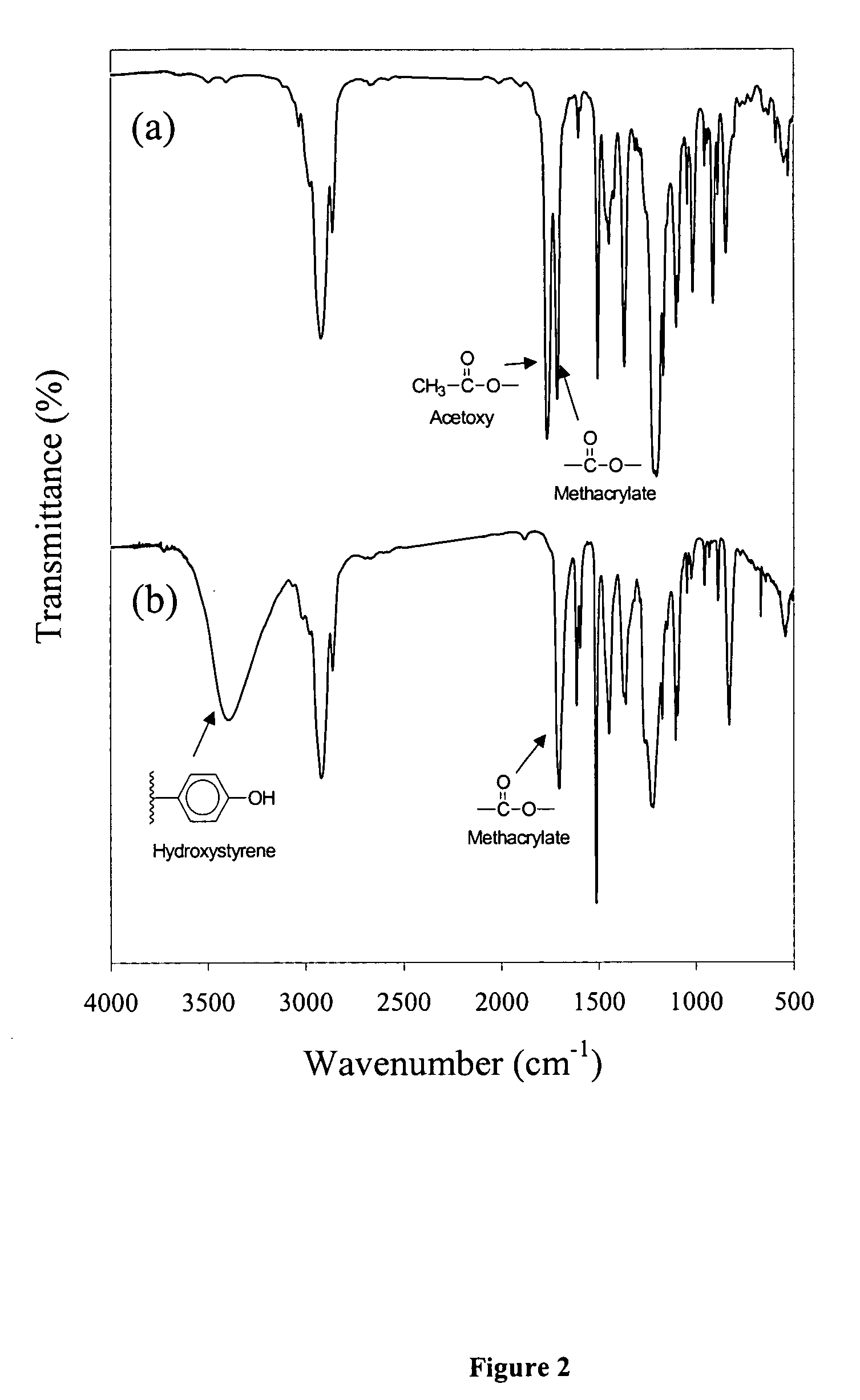High resolution resists for next generation lithographies
a lithography and high-resolution technology, applied in the field of resists, can solve the problems of phase separation, non-uniform acid distribution, and limited compatibility of small molecule pags with resist polymer matrix, and achieve the effects of improving etch resistance, improving pattern definition, and improving outgassing properties
- Summary
- Abstract
- Description
- Claims
- Application Information
AI Technical Summary
Benefits of technology
Problems solved by technology
Method used
Image
Examples
example 1
Preparation of Polymeric Resists Comprising Hydroxystyrene Component, Adamantyl Component, and Photoacid Generator Blend
Synthesis of Poly(4-hydroxystyrene-co-2-(4-methoxybutyl)-2-adamantyl methacrylate)
[0070] Polymers were prepared by free radical polymerization in sealed pressure vessels. 4-Acetoxystyrene (AcOSty), 2-(4-methoxybutyl)-2-adamantyl methacrylate (MBAMA), and 2-2′-azobisisobutyronitrile (AIBN) as an initiator were dissolved in freshly dried tetrahydrofuran. Polymerization was performed at 65° C. for 24 hours, precipitated into a large amount of methanol, and dried at reduced pressure. Poly(AcOSty-co-MBAMA) was obtained as a white powder. Poly(AcOSty-co-MBAMA) with various molar feed ratios are summarized in Table 1.
[0071] Poly(4-hydroxystyrene-co-2-(4-methoxybutyl)-2-adamantyl methacrylate) [poly(HOSty-co-MBAMA)] was subsequently obtained by dispersing poly(AcOSty-co-MBAMA) copolymer in a mixture of ammonium hydroxide and methanol for six hours. After dissolution, t...
example 2
Preparation of Polymeric Resists Comprising Photoacid Generating Component Incorporated in Polymeric Chain
Synthesis of Poly(4-hydroxystyrene-co-2-ethyl-2-adamantyl methacrylate-co-4-dimethylsulfonium triflate)
[0084] Polymeric resists 1 through 4 comprising poly(4-hydroxystyrene-co-2-ethyl-2-adamantyl methacrylate-co-4-dimethylsulfonium triflate) were prepared by free radical polymerization in sealed pressure vessels. 4-Hydroxystyrene (HOST), ethyl-adamantyl methacrylate (EAMA), a vinyl photoacid generator, such as phenyl methacrylate 4-(dimethylsulfonium triflate) [p-CH═C(CH3)C(O)OC6H4SMe2]OSO2CF3] and 2,2′-azobisisobutyronitrile (AIBN) as an initiator were dissolved in freshly dried tetrahydrofuran (THF) and acetonitrile. Polymerization was performed at 65° C. for 24 hours and precipitated into a large amount of petroleum ether and dried at reduced pressure. Poly[HOST-co-EAMA-co-phenyl methacrylate 4-(dimethylsulfonium triflate)] was obtained as a white powder. The synthesis is ...
PUM
| Property | Measurement | Unit |
|---|---|---|
| wavelength | aaaaa | aaaaa |
| wavelength | aaaaa | aaaaa |
| glass transition temperature | aaaaa | aaaaa |
Abstract
Description
Claims
Application Information
 Login to View More
Login to View More - R&D
- Intellectual Property
- Life Sciences
- Materials
- Tech Scout
- Unparalleled Data Quality
- Higher Quality Content
- 60% Fewer Hallucinations
Browse by: Latest US Patents, China's latest patents, Technical Efficacy Thesaurus, Application Domain, Technology Topic, Popular Technical Reports.
© 2025 PatSnap. All rights reserved.Legal|Privacy policy|Modern Slavery Act Transparency Statement|Sitemap|About US| Contact US: help@patsnap.com



